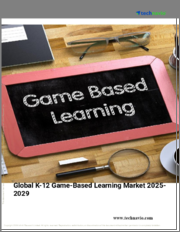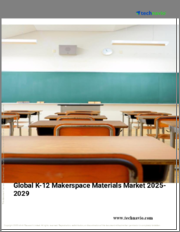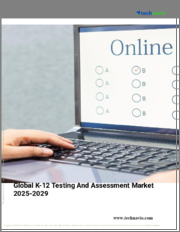
|
시장보고서
상품코드
1804265
세계의 K-12 교과서 시장 : 유형, 학교 레벨, 최종사용자, 유통 채널, 지역별 - 시장 규모, 산업 역학, 기회 분석, 예측(2025-2033년)Global K-12 Textbook Market: By Type, School Level, End Users, Distribution Channel, Region-Market Size, Industry Dynamics, Opportunity Analysis and Forecast for 2025-2033 |
||||||
세계 K-12 교과서 시장은 전통적인 종이 매체와 디지털 학습 솔루션의 진화하는 트렌드에 영향을 받아 큰 변화의 시기를 맞이하고 있습니다. 시장 규모는 2024년 약 203억 9,000만 달러에서 꾸준히 성장하여 2033년에는 354억 5,000만 달러에 달할 것으로 예측되며, 2025년부터 2033년까지 6.61%의 연평균 복합 성장률(CAGR)을 보일 것으로 예측됩니다. 이러한 시장 확대는 교육에 대한 정부의 지속적인 자금 투입과 지속적인 기술 혁신 등 몇 가지 중요한 요인에 의해 촉진될 것으로 보입니다.
유럽은 2024년 72억 달러 이상의 매출을 기록했습니다. 이를 통해 유럽은 이 분야의 세계 리더가 되었습니다. 그 배경에는 교육에 대한 강력한 공공 투자, 오랜 학문적 엄격함의 전통, 다양성이 풍부한 교육 환경이 있습니다. 유럽에서는 독일, 영국, 프랑스, 이탈리아가 주요 기여국이며, 이들 4개국이 대륙 전체 연간 교과서 판매량의 절반 이상을 차지하고 있습니다. 독일의 우위는 중앙집권적인 커리큘럼 체계와 전국에 효율적으로 교육 자료를 공급할 수 있는 강력한 출판 산업이 뒷받침하고 있습니다. 영국은 국가 커리큘럼에 대한 집중과 국제 교육 표준에 대한 관심 증가라는 이중적 초점을 통해 다양한 교과서 수요를 확대하고 있습니다.
시장 세분화 세부 정보
유형별로는 여전히 인쇄교재에 의해 주도되고 있으며, 2024년에는 전체 매출의 53.80% 이상을 차지했습니다. 인쇄된 교과서가 강력한 지지를 받는 이유는 그 유형성과 보편적으로 접근 가능한 특성으로 인해 전 세계 학습자와 교육자들에게 신뢰할 수 있는 교재로 남아있기 때문입니다. 디지털 교재와 달리 인쇄 교과서는 전자기기나 인터넷 연결이 필요하지 않기 때문에 기술 인프라의 유무에 관계없이 다양한 교육 환경에서 사용할 수 있습니다.
최종 사용자별로는 교육기관이 전체 시장 점유율의 96% 이상을 차지하며 압도적인 지위를 차지하고 있습니다. 이러한 압도적인 우위는 공립 및 사립 학교가 가진 강력한 구매력과 영향력에 의해 뒷받침되고 있습니다. 학교는 매년 수백만 명의 학생들에게 교과서를 제공하기 위해 교과서를 선정, 조달 및 배포하는 데 중심적인 역할을 하고 있으며, 교육 컨텐츠의 주요 관리자로서 교실에서 사용할 교과서를 결정하고 모든 학생들이 필요한 교재를 이용할 수 있도록 하고 있습니다.
교과서 및 교육 자료의 유통은 여전히 오프라인 채널의 영향을 많이 받고 있으며, 여전히 시장의 지배적인 힘으로 남아 있습니다. 2024년에는 오프라인 판매가 전체 시장 매출의 73.49% 이상을 차지했으며, 이는 전통적인 소매 채널이 소비자에게 도달하는 데 있어 여전히 중요하다는 것을 보여줍니다. 특히 전문점은 이 오프라인 시장에서 중요한 역할을 담당하고 있으며, 교과서를 신뢰할 수 있는 형태로 제공하고, 즉각적인 가용성과 다양한 교재를 직접 확인할 수 있다는 장점이 있습니다.
세계의 K-12 교과서 시장을 조사했으며, 시장 개요, 시장 성장에 영향을 미치는 각종 영향요인 분석, 시장 규모 추이 및 예측, 각종 분류별 상세 분석, 경쟁 구도, 주요 기업 개요 등의 정보를 전해드립니다.
목차
제1장 조사 프레임워크
- 조사 목적
- 제품 개요
- 시장 세분화
제2장 조사 방법
제3장 주요 요약 : 세계의 K-12 교과서 시장
제4장 세계의 K-12 교과서 시장 : 개요
- 밸류체인 분석
- 산업 전망
- PESTLE 분석
- Porter의 Five Forces 분석
- 시장 역학과 동향
- 시장 성장 동향에 대한 COVID-19의 영향 평가
- 시장 성장과 전망
- 경쟁 대시보드
제5장 세계의 K-12 교과서 시장 분석 : 유형별
- 주요 인사이트
- 시장 규모와 예측
- 디지털 교재
- 인쇄 교재
제6장 세계의 K-12 교과서 시장 분석 : 학교 레벨별
- 주요 인사이트
- 시장 규모와 예측
- 초등교육(K-5)
- 중등교육(6-8학년)
- 고등교육(9-12학년)
제7장 세계의 K-12 교과서 시장 분석 : 최종사용자별
- 주요 인사이트
- 시장 규모와 예측
- 개인(자택 교육 방법)
- 교육기관
제8장 세계의 K-12 교과서 시장 분석 : 유통 채널별
- 주요 인사이트
- 시장 규모와 예측
- 온라인
- 오프라인
제9장 세계의 K-12 교과서 시장 분석 : 지역별
- 주요 인사이트
- 시장 규모와 예측
- 북미
- 유럽
- 아시아태평양
- 중동 및 아프리카
- 남미
제10장 북미의 K-12 교과서 시장 분석
- 주요 인사이트
- 시장 규모와 예측
- 유형별
- 학교 레벨별
- 최종사용자별
- 유통 채널별
- 국가별
제11장 유럽의 K-12 교과서 시장 분석
- 주요 인사이트
- 시장 규모와 예측
- 유형별
- 학교 레벨별
- 최종사용자별
- 유통 채널별
- 국가별
제12장 아시아태평양의 K-12 교과서 시장 분석
- 주요 인사이트
- 시장 규모와 예측
- 유형별
- 학교 레벨별
- 최종사용자별
- 유통 채널별
- 국가별
제13장 중동 및 아프리카의 K-12 교과서 시장 분석
- 주요 인사이트
- 시장 규모와 예측
- 유형별
- 학교 레벨별
- 최종사용자별
- 유통 채널별
- 국가별
제14장 남미의 K-12 교과서 시장 분석
- 주요 인사이트
- 시장 규모와 예측
- 유형별
- 학교 레벨별
- 최종사용자별
- 유통 채널별
- 국가별
제15장 영국의 K-12 교과서 시장 분석
제16장 독일의 K-12 교과서 시장 분석
제17장 프랑스의 K-12 교과서 시장 분석
제18장 이탈리아의 K-12 교과서 시장 분석
제19장 스페인의 K-12 교과서 시장 분석
제20장 폴란드의 K-12 교과서 시장 분석
제21장 러시아의 K-12 교과서 시장 분석
제22장 노르웨이의 K-12 교과서 시장 분석
제23장 네덜란드의 K-12 교과서 시장 분석
제24장 스웨덴의 K-12 교과서 시장 분석
제25장 기타 유럽의 K-12 교과서 시장 분석
제26장 기업 개요
- Blake Education
- Cengage Group
- Discovery Education
- HarperCollins Publishers Ltd.
- HMH Education Company
- Macmillan Education Limited
- McGraw Hill
- Pearson plc
- Penguin Random House
- Prachi(India)Pvt. Ltd.
- Scholastic Inc.
- 기타 주요 기업
제27장 부록
LSH 25.09.11The global K-12 textbook market is undergoing a significant transformation, influenced by evolving trends in both traditional print materials and digital learning solutions. In 2024, the market was valued at approximately US$20.39 billion, and it is projected to grow steadily, reaching an estimated valuation of US$35.45 billion by 2033. This represents a compound annual growth rate (CAGR) of 6.61% over the forecast period from 2025 to 2033. The market's expansion is expected to be driven by several key factors, including sustained government funding for education and ongoing technological advancements.
Europe stands out as the dominant region in the K-12 textbook market, generating revenues exceeding US$7.20 billion in 2024. This makes Europe the global leader in this sector, thanks to strong public investment in education, a long-standing tradition of academic rigor, and a highly diverse educational landscape. Within Europe, Germany, the United Kingdom, France, and Italy emerge as the top contributors, collectively accounting for more than half of the continent's annual textbook sales. Germany's dominance is supported by its centralized curriculum framework and a robust publishing industry that efficiently supplies educational materials nationwide. The United Kingdom benefits from its dual focus on national curricula and a growing emphasis on international educational standards, broadening the market for diverse textbook offerings.
Noteworthy Market Developments
The K-12 textbook market is characterized by its dynamic and competitive nature, with both long-established publishers and innovative EdTech companies vying for a larger share of the market. There is an increasing emphasis on digital solutions that provide engaging, personalized, and adaptable learning experiences tailored to the diverse needs of K-12 students.
Among the key players dominating the market are major publishers such as Pearson, McGraw-Hill, and Houghton Mifflin Harcourt, now known as HMH Education Company. These companies have built extensive portfolios that include both print and digital learning materials, encompassing textbooks, assessment tools, and a variety of supplementary resources designed to support teachers and students alike. Pearson, recognized as a global leader in education, offers an expansive range of K-12 products and services.
In addition to these traditional publishers, partnerships and initiatives are expanding textbook availability and accessibility in various regions. For instance, Amazon India recently announced a significant collaboration with the National Council of Educational Research and Training (NCERT) through a Letter of Engagement. This partnership ensures that NCERT textbooks will be sold at their Maximum Retail Price (MRP) across India, guaranteeing access to authentic and affordable learning materials.
Core Growth Drivers
Government funding plays a crucial and foundational role in driving the K-12 textbook market, significantly influencing both the quantity and quality of educational materials accessible to students. In 2024, the combined financial investment from federal and state governments in the United States surpassed US$100 billion for K-12 education. A substantial portion of this funding is allocated specifically for the procurement of textbooks and the modernization of curricula, ensuring that schools can offer up-to-date and relevant learning resources. This infusion of funds enables districts to adopt new materials that align with evolving educational standards and integrate emerging technologies, thereby enhancing the overall learning experience for students.
Emerging Opportunity Trends
A defining trend shaping the K-12 textbook market in 2024 is the growing emphasis on learner agency, which centers on empowering students to actively take control of their educational journey. This shift marks a significant departure from traditional one-size-fits-all approaches, moving towards more personalized and student-centered learning experiences. One of the clearest manifestations of this trend is the widespread adoption of customizable and adaptive textbooks.
Major publishers have responded to this demand by developing modular textbook platforms that give students the ability to select specific chapters, supplementary resources, and interactive exercises tailored to their individual needs. This flexibility allows learners to focus on areas where they require additional practice or to explore topics that spark their curiosity, fostering greater motivation and ownership over their studies. In the United States alone, this approach has gained considerable traction, with over 5,000 school districts implementing digital textbook solutions.
Barriers to Optimization
In 2024, the K-12 textbook market is grappling with a significant obstacle: the ongoing challenge of attracting and retaining qualified educators and IT professionals. This issue has far-reaching consequences, as it directly affects the ability of schools to effectively adopt and utilize new textbook resources. Across the United States, school districts began the academic year with more than 30,000 unfilled positions spanning both teaching roles and technology support staff.
A striking example of this challenge is evident in a major urban school district in Texas, which started the year facing over 2,000 teacher vacancies. To cope with such a deficit, schools have been forced to depend heavily on substitute teachers, who often lack the continuity and familiarity with the curriculum necessary for effective teaching. This situation limits the schools' capacity to roll out new textbooks and educational programs as planned, undermining efforts to improve learning outcomes.
Detailed Market Segmentation
By Type, the textbook market continues to be predominantly driven by print materials, which accounted for over 53.80% of the total revenue in 2024. This strong preference for print textbooks is due to their tangible and universally accessible nature, making them a reliable and trusted resource for learners and educators across the globe. Unlike digital formats, print textbooks do not require electronic devices or internet connectivity, which ensures that they remain usable in a wide variety of educational settings regardless of technological infrastructure.
By End-User, educational institutions hold a commanding position in the global textbook market, representing over 96% of the total market share. This overwhelming dominance is driven by the substantial purchasing power and influence of both public and private schools, which play a central role in determining the selection, procurement, and distribution of textbooks to millions of students annually. These institutions act as the primary gatekeepers of educational content, making critical decisions that affect which textbooks are used in classrooms and ensuring that each student has access to the necessary learning materials.
The distribution of textbooks and educational materials continues to be heavily influenced by the offline channel, which remains the dominant force in the market. In 2024, offline sales are projected to account for more than 73.49% of the total market revenue, underscoring the sustained importance of traditional retail avenues in reaching consumers. Specialty stores, in particular, play a crucial role within this offline landscape. These stores are trusted sources for textbooks, offering the advantage of immediate product availability and the ability to browse a wide selection of materials.
By School Level, primary education, encompassing kindergarten through fifth grade (K-5), stands as the cornerstone of the global educational market, generating a significant 43.02% of the revenue in 2024. This segment's dominance is largely due to the vast number of students enrolled at the primary level worldwide. With over 600 million children attending primary schools globally, the demand for educational materials, particularly textbooks, remains consistently high. These textbooks cover essential core subjects such as language arts, mathematics, science, and social studies, which form the foundation of formal learning for young students.
Segment Breakdown
By Type
- Digital Textbooks
- Print Textbooks
By School Level
- Primary Education (K-5)
- Secondary Education (6-8)
- Higher Education (9-12)
By End User
- Individuals (Home Schooling)
- Educational Institutes
By Distribution Channel
- Online
- E-Marketplace
- Brand Websites
- Offline
- Specialty Stores
- Others
By Region
- North America
- The U.S.
- Canada
- Mexico
- Europe
- The UK
- Germany
- France
- Italy
- Spain
- Poland
- Russia
- Rest of Europe
- Asia Pacific
- China
- India
- Japan
- South Korea
- Australia & New Zealand
- ASEAN
- Malaysia
- Singapore
- Thailand
- Indonesia
- Philippines
- Vietnam
- Rest of ASEAN
- Rest of Asia Pacific
- Middle East & Africa
- UAE
- Saudi Arabia
- South Africa
- Rest of MEA
- South America
- Argentina
- Brazil
- Rest of South America
Leading Market Participants
- Blake Education
- Cengage Group
- Discovery Education
- HarperCollins Publishers Ltd.
- HMH Education Company
- Macmillan Education Limited
- McGraw Hill
- Pearson plc
- Penguin Random House
- Prachi [India] Pvt. Ltd.
- Scholastic Inc.
- Other Prominent Players
Table of Content
Chapter 1. Research Framework
- 1.1 Research Objective
- 1.2 Product Overview
- 1.3 Market Segmentation
Chapter 2. Research Methodology
- 2.1 Qualitative Research
- 2.1.1 Primary & Secondary Sources
- 2.2 Quantitative Research
- 2.2.1 Primary & Secondary Sources
- 2.3 Breakdown of Primary Research Respondents, By Region
- 2.4 Assumption for the Study
- 2.5 Market Size Estimation
- 2.6. Data Triangulation
Chapter 3. Executive Summary: Global K-12 Textbook Market
Chapter 4. Global K-12 Textbook Market Overview
- 4.1. Industry Value Chain Analysis
- 4.1.1. Material Provider
- 4.1.2. Manufacturer
- 4.1.3. Distributor
- 4.1.4. End User
- 4.2. Industry Outlook
- 4.2.1. EXIM of Printed Reading Books
- 4.2.2. Global Expenditure on K-12 Education
- 4.2.3. Education Expenditure in European Countries as % of GDP, 2023
- 4.3. PESTLE Analysis
- 4.4. Porter's Five Forces Analysis
- 4.4.1. Bargaining Power of Suppliers
- 4.4.2. Bargaining Power of Buyers
- 4.4.3. Threat of Substitutes
- 4.4.4. Threat of New Entrants
- 4.4.5. Degree of Competition
- 4.5. Market Dynamics and Trends
- 4.5.1. Growth Drivers
- 4.5.2. Restraints
- 4.5.3. Challenges
- 4.5.4. Key Trends
- 4.6. Covid-19 Impact Assessment on Market Growth Trend
- 4.7. Market Growth and Outlook
- 4.7.1. Market Revenue Estimates and Forecast (US$ Mn), 2020-2033
- 4.7.2. Price Trend Analysis
- 4.8. Competition Dashboard
- 4.8.1. Market Concentration Rate
- 4.8.2. Company Market Share Analysis (Value %), 2024
- 4.8.3. Competitor Mapping & Benchmarking
Chapter 5. Global K-12 Textbook Market Analysis, By Type
- 5.1. Key Insights
- 5.2. Market Size and Forecast, 2020 - 2033 (US$ Mn)
- 5.2.1. Digital Textbooks
- 5.2.2. Print Textbooks
Chapter 6. Global K-12 Textbook Market Analysis, By School Level
- 6.1. Key Insights
- 6.2. Market Size and Forecast, 2020 - 2033 (US$ Mn)
- 6.2.1. Primary Education (K-5)
- 6.2.2. Secondary Education (6-8)
- 6.2.3. Higher Education (9-12)
Chapter 7. Global K-12 Textbook Market Analysis, By End User
- 7.1. Key Insights
- 7.2. Market Size and Forecast, 2020 - 2033 (US$ Mn)
- 7.2.1. Individuals (Home Schooling)
- 7.2.2. Educational Institutes
Chapter 8. Global K-12 Textbook Market Analysis, By Distribution Channel
- 8.1. Key Insights
- 8.2. Market Size and Forecast, 2020 - 2033 (US$ Mn)
- 8.2.1. Online
- 8.2.1.1. E-Marketplace
- 8.2.1.2. Brand Websites
- 8.2.2. Offline
- 8.2.2.1. Specialty Stores
- 8.2.2.2. Others
- 8.2.1. Online
Chapter 9. Global K-12 Textbook Market Analysis, By Region
- 9.1. Key Insights
- 9.2. Market Size and Forecast, 2020 - 2033 (US$ Mn)
- 9.2.1. North America
- 9.2.1.1. The U.S.
- 9.2.1.2. Canada
- 9.2.1.3. Mexico
- 9.2.2. Europe
- 9.2.2.1. The UK
- 9.2.2.2. Germany
- 9.2.2.3. France
- 9.2.2.4. Italy
- 9.2.2.5. Spain
- 9.2.2.6. Poland
- 9.2.2.7. Russia
- 9.2.2.8. Rest of Europe
- 9.2.3. Asia Pacific
- 9.2.3.1. China
- 9.2.3.2. India
- 9.2.3.3. Japan
- 9.2.3.4. Singapore
- 9.2.3.5. South Korea
- 9.2.3.6. Australia & New Zealand
- 9.2.3.7. ASEAN
- 9.2.3.8. Rest of Asia Pacific
- 9.2.4. Middle East & Africa
- 9.2.4.1. UAE
- 9.2.4.2. Saudi Arabia
- 9.2.4.3. South Africa
- 9.2.4.4. Rest of MEA
- 9.2.5. South America
- 9.2.5.1. Argentina
- 9.2.5.2. Brazil
- 9.2.5.3. Rest of South America
- 9.2.1. North America
Chapter 10. North America K-12 Textbook Market Analysis
- 10.1. Key Insights
- 10.2. Market Size and Forecast, 2020 - 2033 (US$ Mn)
- 10.2.1. By Type
- 10.2.2. By School Level
- 10.2.3. By End User
- 10.2.4. By Distribution Channel
- 10.2.5. By Country
Chapter 11. Europe K-12 Textbook Market Analysis
- 11.1. Key Insights
- 11.2. Market Size and Forecast, 2020 - 2033 (US$ Mn)
- 11.2.1. By Type
- 11.2.2. By School Level
- 11.2.3. By End User
- 11.2.4. By Distribution Channel
- 11.2.5. By Country
Chapter 12. Asia Pacific K-12 Textbook Market Analysis
- 12.1. Key Insights
- 12.2. Market Size and Forecast, 2020 - 2033 (US$ Mn)
- 12.2.1. By Type
- 12.2.2. By School Level
- 12.2.3. By End User
- 12.2.4. By Distribution Channel
- 12.2.5. By Country
Chapter 13. Middle East and Africa K-12 Textbook Market Analysis
- 13.1. Key Insights
- 13.2. Market Size and Forecast, 2020 - 2033 (US$ Mn)
- 13.2.1. By Type
- 13.2.2. By School Level
- 13.2.3. By End User
- 13.2.4. By Distribution Channel
- 13.2.5. By Country
Chapter 14. South America K-12 Textbook Market Analysis
- 14.1. Key Insights
- 14.2. Market Size and Forecast, 2020 - 2033 (US$ Mn)
- 14.2.1. By Type
- 14.2.2. By School Level
- 14.2.3. By End User
- 14.2.4. By Distribution Channel
- 14.2.5. By Country
Chapter 15. The UK K-12 Textbook Market Analysis
- 15.1. Key Insights
- 15.2. Market Size and Forecast, 2020 - 2033 (US$ Mn)
- 15.2.1. By Type
- 15.2.2. By School Level
- 15.2.3. By End User
- 15.2.4. By Distribution Channel
Chapter 16. Germany K-12 Textbook Market Analysis
- 16.1. Key Insights
- 16.2. Market Size and Forecast, 2020 - 2033 (US$ Mn)
- 16.2.1. By Type
- 16.2.2. By School Level
- 15.2.3. By End User
- 15.2.4. By Distribution Channel
Chapter 17. France K-12 Textbook Market Analysis
- 17.1. Key Insights
- 17.2. Market Size and Forecast, 2020 - 2033 (US$ Mn)
- 17.2.1. By Type
- 17.2.2. By School Level
- 17.2.3. By End User
- 17.2.4. By Distribution Channel
Chapter 18. Italy K-12 Textbook Market Analysis
- 18.1. Key Insights
- 18.2. Market Size and Forecast, 2020 - 2033 (US$ Mn)
- 18.2.1. By Type
- 18.2.2. By School Level
- 18.2.3. By End User
- 18.2.4. By Distribution Channel
Chapter 19. Spain K-12 Textbook Market Analysis
- 19.1. Key Insights
- 19.2. Market Size and Forecast, 2020 - 2033 (US$ Mn)
- 19.2.1. By Type
- 19.2.2. By School Level
- 19.2.3. By End User
- 19.2.4. By Distribution Channel
Chapter 20. Poland K-12 Textbook Market Analysis
- 20.1. Key Insights
- 20.2. Market Size and Forecast, 2020 - 2033 (US$ Mn)
- 20.2.1. By Type
- 20.2.2. By School Level
- 20.2.3. By End User
- 20.2.4. By Distribution Channel
Chapter 21. Russia K-12 Textbook Market Analysis
- 21.1. Key Insights
- 21.2. Market Size and Forecast, 2020 - 2033 (US$ Mn)
- 21.2.1. By Type
- 21.2.2. By School Level
Chapter 22. Norway K-12 Textbook Market Analysis
- 22.1. Key Insights
- 22.2. Market Size and Forecast, 2020 - 2033 (US$ Mn)
- 22.2.1. By Type
- 22.2.2. By School Level
- 22.2.3. By End User
- 22.2.4. By Distribution Channel
Chapter 23. The Netherlands K-12 Textbook Market Analysis
- 23.1. Key Insights
- 23.2. Market Size and Forecast, 2020 - 2033 (US$ Mn)
- 23.2.1. By Type
- 23.2.2. By School Level
- 23.2.3. By End User
- 23.2.4. By Distribution Channel
Chapter 24. Sweden K-12 Textbook Market Analysis
- 24.1. Key Insights
- 24.2. Market Size and Forecast, 2020 - 2033 (US$ Mn)
- 24.2.1. By Type
- 24.2.2. By School Level
- 24.2.3. By End User
- 24.2.4. By Distribution Channel
Chapter 25. Rest of Europe K-12 Textbook Market Analysis
- 25.1. Key Insights
- 25.2. Market Size and Forecast, 2020 - 2033 (US$ Mn)
- 25.2.1. By Type
- 25.2.2. By School Level
- 25.2.3. By End User
- 25.2.4. By Distribution Channel
Chapter 26. Company Profile (Company Overview, Financial Matrix, Key Product landscape, Key Personnel, Key Competitors, Contact Address, and Business Strategy Outlook)
- 26.1. Blake Education
- 26.2. Cengage Group
- 26.3. Discovery Education
- 26.4. HarperCollins Publishers Ltd.
- 26.5. HMH Education Company
- 26.6. Macmillan Education Limited
- 26.7. McGraw Hill
- 26.8. Pearson plc
- 26.9. Penguin Random House
- 26.10. Prachi [India] Pvt. Ltd.
- 26.11. Scholastic Inc.
- 26.12. Other Prominent Players
Chapter 27. Annexure
- 27.1. List of Secondary Sources
- 27.2. Key Country Markets- Macro Economic Outlook/Indicators



















